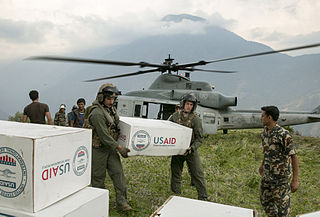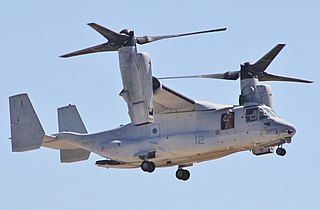
The Bell AH-1 Cobra is a two-blade, single-engine attack helicopter manufactured by Bell Helicopter. It was developed using the engine, transmission and rotor system of the Bell UH-1 Iroquois. A member of the prolific Huey family, the AH-1 is also referred to as the HueyCobra or Snake.

The Bell UH-1 Iroquois is a utility military helicopter powered by a single turboshaft engine, with two-blade main and tail rotors. The first member of the prolific Huey family, it was developed by Bell Helicopter to meet a United States Army's 1952 requirement for a medical evacuation and utility helicopter, and first flew in 1956. The UH-1 was the first turbine-powered helicopter produced for the United States military, and more than 16,000 have been built since 1960.

The Royal Thai Navy or RTN is the naval force of Thailand and part of the Royal Thai Armed Forces. It was established in the late-19th century. Similar to the organisational structure of the United States, the Royal Thai Navy includes the naval fleet and the Royal Thai Marine Corps. The Royal Thai Navy operates out of Sattahip Naval Base in Sattahip Bay. Thailand is the only Southeast Asian country that operates an aircraft carrier, though it is used as a pure helicopter carrier with the retirement of its Harrier fighter wing. Thailand was the second Asian nation to acquire submarines, following Japan, but has had no submarines since 1950.
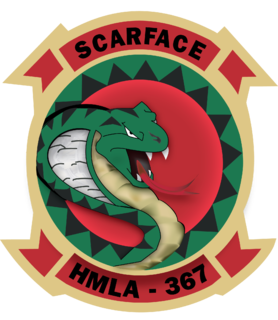
Marine Light Attack Helicopter Squadron 367 (HMLA-367) is a United States Marine Corps helicopter squadron consisting of AH-1Z Viper attack helicopters and UH-1Y Venom utility helicopters. The squadron is based at Marine Corps Base Kaneohe Bay, Hawaii and falls under the command of Marine Aircraft Group 24 (MAG-24) and the 1st Marine Aircraft Wing.

Sindhupalchok District is a part of Province No. 3 and one of the seventy-seven districts of Nepal, with an area of 2,542 km2 (981 sq mi). The district's headquarters is in Chautara. In 2006, 336,478 people resided in 79 village development committees, in 2011 there were 287,798.
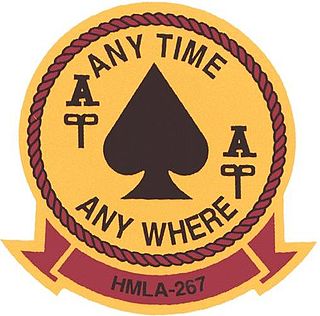
Marine Light Attack Helicopter Squadron 267 (HMLA-267) is a United States Marine Corps helicopter squadron consisting of AH-1Z Viper attack helicopters and UH-1Y Huey utility helicopters. The squadron is based at Marine Corps Base Camp Pendleton, California falls under the command of Marine Aircraft Group 39 (MAG-39) and the 3rd Marine Aircraft Wing.

Marine Light Attack Helicopter Squadron 169 (HMLA-169) is a United States Marine Corps helicopter squadron consisting of AH-1Z SuperCobra attack helicopters and UH-1Y Huey utility helicopters. The squadron is based at Marine Corps Air Station Camp Pendleton, California and falls under the command of Marine Aircraft Group 39 (MAG-39) and the 3rd Marine Aircraft Wing.

Marine Light Attack Helicopter Training Squadron 303 (HMLAT-303), is a United States Marine Corps helicopter training squadron stationed at Marine Corps Base Camp Pendleton, California. Known as the "Atlas", HMLAT-303 trains newly commissioned Naval Aviators, conversion pilots, and refresher pilots to fly the Bell UH-1Y Venom and Bell AH-1Z Viper. HMLAT-303 is also responsible for training Bell UH-1Y Venom crew chiefs. It is part of Marine Aircraft Group 39 (MAG-39) and the 3rd Marine Aircraft Wing.

The EurocopterUH-72 Lakota is a twin-engine helicopter with a single, four-bladed main rotor. The UH-72 is a militarized version of the Eurocopter EC145 and was built by American Eurocopter, a division of Airbus Group, Inc. Initially marketed as the UH-145, the helicopter was selected as the winner of the United States Army's Light Utility Helicopter (LUH) program on 30 June 2006. In October 2006, American Eurocopter was awarded a production contract for 345 aircraft to replace aging UH-1H/V and OH-58A/C helicopters in the US Army and Army National Guard fleets. It performs logistics and support missions within the US and the National Guard for homeland security, disaster response missions, and medical evacuations.

The AgustaWestland AW139 is a 15-seat medium-sized twin-engined helicopter developed and built by AgustaWestland and now produced by Italian company Leonardo. It is marketed at several different roles, including VIP/corporate transport, offshore transport, fire fighting, law enforcement, search and rescue, emergency medical service, disaster relief, and maritime patrol. In addition to AgustaWestland's manufacturing facilities in Italy and the United States, the AW139 is produced in Russia by HeliVert, a joint venture between AgustaWestland and Russian Helicopters.

The Bell UH-1N Twin Huey is a twin-engined, medium military helicopter. A member of the extensive Huey family, it first flew in 1969. The CUH-1N Twin Huey was the original version, first ordered by the Canadian Forces.

The Bell AH-1Z Viper is an American twin-engine attack helicopter, based on the AH-1W SuperCobra, that was developed for the United States Marine Corps as part of the H-1 upgrade program. The AH-1Z features a four-blade, bearingless, composite main rotor system, uprated transmission, and a new target sighting system. The AH-1Z, one of the latest members of the prolific Bell Huey family, is also called "Zulu Cobra", based on the military phonetic alphabet pronunciation of its variant letter.

Marine Light Attack Helicopter Squadron 467 (HMLA-467) was a United States Marine Corps helicopter squadron consisting of AH-1W SuperCobra attack helicopters and UH-1Y Venom utility helicopters. The squadron, nicknamed the "Sabers", was based at Marine Corps Air Station New River, North Carolina and falls under the command of Marine Aircraft Group 29 (MAG-29) and the 2nd Marine Aircraft Wing. The squadron's aircraft markings are grey & white stripes on the aircraft tail to replicate the tail markings on a Diamondback Rattlesnake and the markings on the lighthouses in North Carolina.
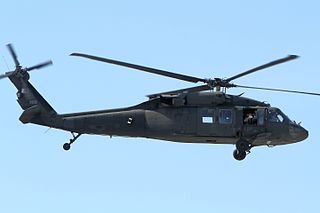
On March 10, 2015, a Sikorsky UH-60 Black Hawk helicopter of the United States Army crashed off the coast of the Florida Panhandle during a training exercise at Eglin Air Force Base, killing all eleven people on board. The helicopter was reported missing during foggy conditions at 8:30 PM. The helicopter was assigned to the 1-244th Assault Helicopter Battalion in Hammond, Louisiana.

Operation Sankat Mochan is a Nepal Army earthquake relief operation following the April 2015 Nepal earthquake; the Nepal Army has deployed 90 percent of its force.

A major earthquake occurred in Nepal on 12 May 2015 at 12:50 pm local time with a moment magnitude of 7.3, 18 km (11 mi) southeast of Kodari. The epicenter was on the border of Dolakha and Sindhupalchowk, two districts of Nepal. This earthquake occurred on the same fault as the larger magnitude 7.8 earthquake of 25 April, but further east than the original quake. As such, it is considered to be an aftershock of 25 April quake. It struck at a depth of 18.5 kilometres (11.5 mi). Shaking was felt in northern parts of India including Bihar, Uttar Pradesh and West Bengal. Tremors were felt as far as about 2,400 kilometers away from the epicenter in Chennai.



